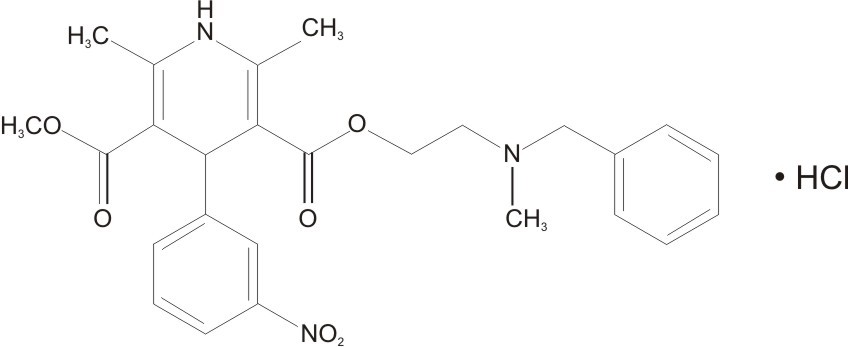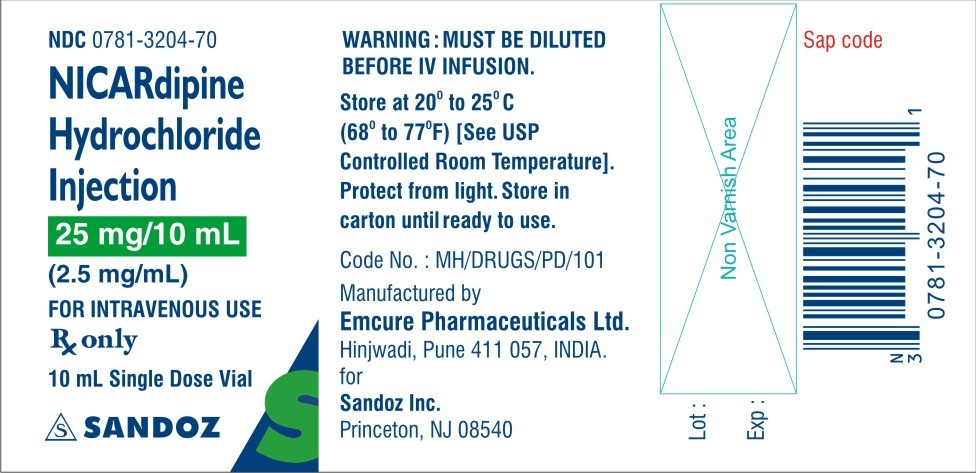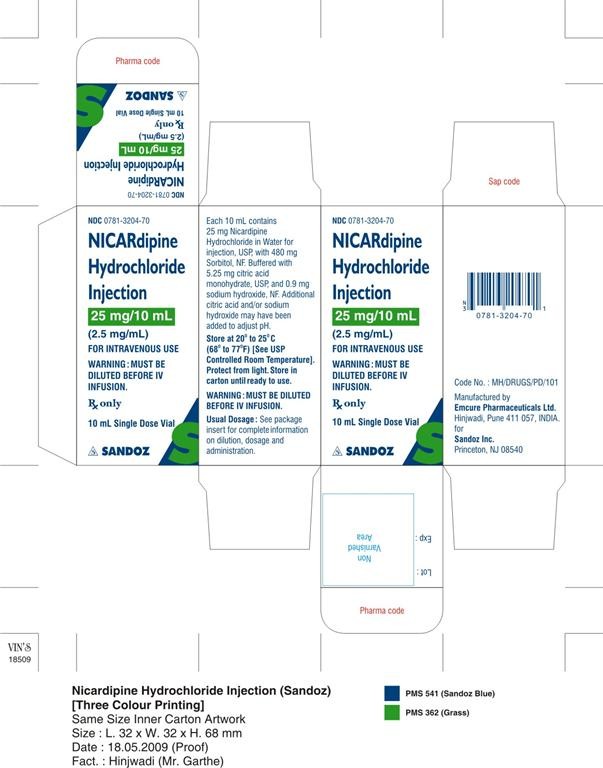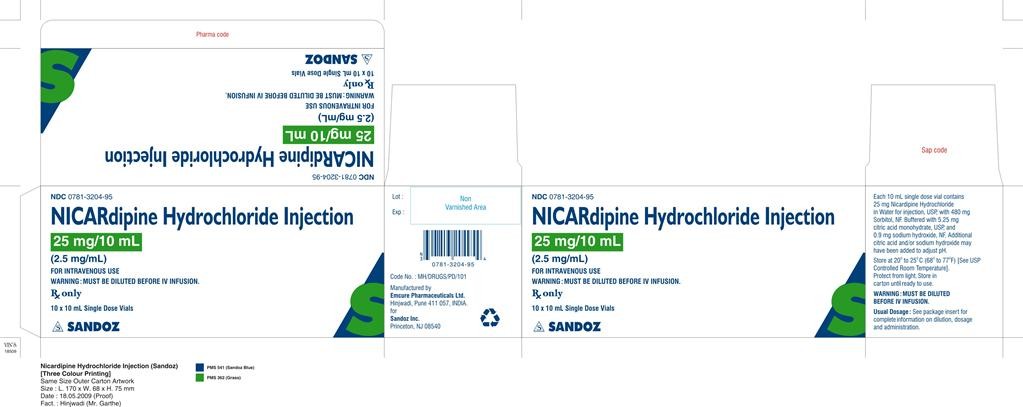Nicardipine Hydrochloride
Rx only
FULL PRESCRIBING INFORMATION: CONTENTS*
- NICARDIPINE HYDROCHLORIDE DESCRIPTION:
- CLINICAL PHARMACOLOGY:
- NICARDIPINE HYDROCHLORIDE INDICATIONS AND USAGE:
- NICARDIPINE HYDROCHLORIDE CONTRAINDICATIONS:
- WARNINGS:
- PRECAUTIONS:
- NICARDIPINE HYDROCHLORIDE ADVERSE REACTIONS:
- OVERDOSAGE:
- NICARDIPINE HYDROCHLORIDE DOSAGE AND ADMINISTRATION:
- HOW SUPPLIED:
- Principal Display Panel_label
- Principal Display Panel_inner carton
- Principal Display Panel_outer carton
FULL PRESCRIBING INFORMATION
DESCRIPTION:
m
 C26 H29 N3 O6 •HCl
C26 H29 N3 O6 •HCl
CLINICAL PHARMACOLOGY:
Mechanism of Action:
Nicardipine inhibits the transmembrane influx of calcium ions into cardiac muscle and smooth muscle without changing serum calcium concentrations. The contractile processes of cardiac muscle and vascular smooth muscle are dependent upon the movement of extracellular calcium ions into these cells through specific ion channels. The effects of nicardipine are more selective to vascular smooth muscle than cardiac muscle. In animal models, nicardipine produced relaxation of coronary vascular smooth muscle at drug levels which cause little or no negative inotropic effect.
Pharmacokinetics and Metabolism:
Following infusion, nicardipine plasma concentrations decline tri-exponentially, with a rapid early distribution phase ((alpha)-half-life of 2.7 minutes), an intermediate phase ((beta)-half-life of 44.8 minutes), and a slow terminal phase ((gamma)-half-life of 14.4 hours) that can only be detected after long-term infusions. Total plasma clearance (Cl) is 0.4 L/hr·kg, and the apparent volume of distribution (Vd ) using a non-compartment model is 8.3 L/kg. The pharmacokinetics of nicardipine hydrochloride injection are linear over the dosage range of 0.5 to 40 mg/hr.
Rapid dose-related increases in nicardipine plasma concentrations are seen during the first two hours after the start of an infusion of nicardipine hydrochloride injection. Plasma concentrations increase at a much slower rate after the first few hours, and approach steady state at 24 to 48 hours. On termination of the infusion, nicardipine concentrations decrease rapidly, with at least a 50% decrease during the first two hours post-infusion. The effects of nicardipine on blood pressure significantly correlate with plasma concentrations.
Nicardipine is highly protein bound (>95%) in human plasma over a wide concentration range.
Nicardipine hydrochloride injection has been shown to be rapidly and extensively metabolized by the liver. After coadministration of a radioactive intravenous dose of nicardipine hydrochloride injection with an oral 30 mg dose given every 8 hours, 49% of the radioactivity was recovered in the urine and 43% in the feces within 96 hours. None of the dose was recovered as unchanged nicardipine.
Nicardipine does not induce or inhibit its own metabolism and does not induce or inhibit hepatic microsomal enzymes.
The steady-state pharmacokinetics of nicardipine are similar in elderly hypertensive patients (>65 years) and young healthy adults.
Hemodynamics:
Nicardipine hydrochloride injection produces significant decreases in systemic vascular resistance. In a study of intra-arterially administered nicardipine hydrochloride injection, the degree of vasodilation and the resultant decrease in blood pressure were more prominent in hypertensive patients than in normotensive volunteers. Administration of nicardipine hydrochloride injection to normotensive volunteers at dosages of 0.25 to 3 mg/hr for eight hours produced changes of <5 mmHg in systolic blood pressure and <3 mmHg in diastolic blood pressure.
An increase in heart rate is a normal response to vasodilation and decrease in blood pressure; in some patients these increases in heart rate may be pronounced. In placebo-controlled trials, the mean increases in heart rate were 7±1 bpm in postoperative patients and 8±1 bpm in patients with severe hypertension at the end of the maintenance period.
Hemodynamic studies following intravenous dosing in patients with coronary artery disease and normal or moderately abnormal left ventricular function have shown significant increases in ejection fraction and cardiac output with no significant change, or a small decrease, in left ventricular end-diastolic pressure (LVEDP). There is evidence that nicardipine increases blood flow. Coronary dilatation induced by nicardipine hydrochloride injection improves perfusion and aerobic metabolism in areas with chronic ischemia, resulting in reduced lactate production and augmented oxygen consumption. In patients with coronary artery disease, nicardipine hydrochloride injection, administered after beta-blockade, significantly improved systolic and diastolic left ventricular function.
In congestive heart failure patients with impaired left ventricular function, nicardipine hydrochloride injection increased cardiac output both at rest and during exercise. Decreases in left ventricular end-diastolic pressure were also observed. However, in some patients with severe left ventricular dysfunction, it may have a negative inotropic effect and could lead to worsened failure.
"Coronary steal" has not been observed during treatment with nicardipine hydrochloride injection (Coronary steal is the detrimental redistribution of coronary blood flow in patients with coronary artery disease from underperfused areas toward better perfused areas.) Nicardipine hydrochloride injection has been shown to improve systolic shortening in both normal and hypokinetic segments of myocardial muscle. Radionuclide angiography has confirmed that wall motion remained improved during increased oxygen demand. (Occasional patients have developed increased angina upon receiving oral nicardipine. Whether this represents coronary steal in these patients, or is the result of increased heart rate and decreased diastolic pressure, is not clear.)
In patients with coronary artery disease, nicardipine hydrochloride injection improves left ventricular diastolic distensibility during the early filling phase, probably due to a faster rate of myocardial relaxation in previously under perfused areas. There is little or no effect on normal myocardium, suggesting the improvement is mainly by indirect mechanisms such as afterload reduction and reduced ischemia. Nicardipine hydrochloride injection has no negative effect on myocardial relaxation at therapeutic doses.
The clinical benefits of these properties have not yet been demonstrated.
Electrophysiologic Effects:
In general, no detrimental effects on the cardiac conduction system have been seen with nicardipine hydrochloride injection. During acute electrophysiologic studies, it increased heart rate and prolonged the corrected QT interval to a minor degree. It did not affect sinus node recovery or SA conduction times. The PA, AH, and HV intervals* or the functional and effective refractory periods of the atrium were not prolonged. The relative and effective refractory periods of the His-Purkinje system were slightly shortened.
*PA=conduction time from high to low right atrium; AH=conduction time from low right atrium to His bundle deflection, or AV nodal conduction time; HV=conduction time through the His bundle and the bundle branch-Purkinje system.
Hepatic Function:
PRECAUTIONSRenal Function:
When nicardipine hydrochloride injection was given to mild to moderate hypertensive patients with moderate degrees of renal impairment, significant reduction in glomerular filtration rate (GFR) and effective renal plasma flow (RPF) was observed. No significant differences in liver blood flow were observed in these patients. A significantly lower systemic clearance and higher area under the curve (AUC) were observed.
When oral nicardipine (20 mg or 30 mg TID) was given to hypertensive patients with impaired renal function, mean plasma concentrations, AUC, and Cmax were approximately two-fold higher than in healthy controls. There is a transient increase in electrolyte excretion, including sodium (see “ PRECAUTIONS ”).
Acute bolus administration of nicardipine hydrochloride injection (2.5 mg) in healthy volunteers decreased mean arterial pressure and renal vascular resistance; glomerular filtration rate (GFR), renal plasma flow (RPF), and the filtration fraction were unchanged. In healthy patients undergoing abdominal surgery, nicardipine hydrochloride injection (10 mg over 20 minutes) increased GFR with no change in RPF when compared with placebo. In hypertensive Type II diabetic patients with nephropathy, oral nicardipine (20 mg TID) did not change RPF and GFR, but reduced renal vascular resistance.
Pulmonary Function:
In two well-controlled studies of patients with obstructive airway disease treated with oral nicardipine, no evidence of increased bronchospasm was seen. In one of the studies, oral nicardipine improved forced expiratory volume 1 second (FEV 1) and forced vital capacity (FVC) in comparison with metoprolol. Adverse experiences reported in a limited number of patients with asthma, reactive airway disease, or obstructive airway disease are similar to all patients treated with oral nicardipine.
Effects In Hypertension:
In patients with mild -to -moderate chronic stable essential hypertension, nicardipine hydrochloride injection (0.5. to 4 mg/hr) produced dose-dependent decreases in blood pressure, although only the decreases at 4 mg/hr were statistically different from placebo. At the end of a 48-hour infusion at 4 mg/hr, the decreases were 26 mmHg (17%) in systolic blood pressure and 20.7 mmHg (20%) in diastolic blood pressure.
In other settings (e.g., patients with severe or postoperative hypertension), nicardipine hydrochloride injection (5 to 15 mg/hr) produced dose-dependent decreases in blood pressure. Higher infusion rates produced therapeutic responses more rapidly. The mean time to therapeutic response for severe hypertension, defined as diastolic blood pressure ≤ 95 mmHg or ≥ 25 mmHg decrease and systolic blood pressure ≤ 160 mmHg, was 77 ±5.2 minutes. The average maintenance dose was 8 mg/hr. The mean time to therapeutic response for postoperative hypertension, defined as ≥ 15% reduction in diastolic or systolic blood pressure, was 11.5 ±0.8 minutes. The average maintenance dose was 3 mg/hr.
INDICATIONS AND USAGE:
Nicardipine hydrochloride injection is indicated for the short-term treatment of hypertension when oral therapy is not feasible or not desirable.
For prolonged control of blood pressure, transfer patients to oral medication as soon as their clinical condition permits (see “ DOSAGE AND ADMINISTRATION ”).
CONTRAINDICATIONS:
Nicardipine hydrochloride injection is contraindicated in patients with advanced aortic stenosis because part of the effect of nicardipine hydrochloride injection is secondary to reduced afterload. Reduction of diastolic pressure in these patients may worsen rather than improve myocardial oxygen balance.
WARNINGS:
Intravenous Infusion Site
To reduce the possibility of venous thrombosis, phlebitis, local irritation, swelling, extravasation, and the occurrence of vascular impairment, administer drug through large peripheral veins or central veins rather than arteries or small peripheral veins, such as those on the dorsum of the hand or wrist. To minimize the risk of peripheral venous irritation, change the site of the drug infusion every 12 hours.
PRECAUTIONS:
General
Blood Pressure: In administering nicardipine, close monitoring of blood pressure and heart rate is required. Nicardipine may occasionally produce symptomatic hypotension or tachycardia. Avoid systemic hypotension when administering the drug to patients who have sustained an acute cerebral infarction or hemorrhage.
Use in Patients with Impaired Hepatic Function: Since nicardipine is metabolized in the liver, consider lower dosages and closely monitor responses in patients with impaired liver function or reduced hepatic blood flow.
Use in Patients with Impaired Renal Function: When nicardipine hydrochloride injection was given to mild to moderate hypertensive patients with moderate renal impairment, a significantly lower systemic clearance and higher area under the curve (AUC) was observed. These results are consistent with those seen after oral administration of nicardipine. Titrate gradually in patients with renal impairment.
DRUG INTERACTIONS:
WARNINGS
Cimetidine
Cimetidine has been shown to increase nicardipine plasma concentrations with oral nicardipine administration. Frequently monitor response in patients receiving both drugs. Data with other histamine-2 antagonists are not available.
Cyclosporine
In Vitro Interaction
The plasma protein binding of nicardipine was not altered when therapeutic concentrations of furosemide, propranolol, dipyridamole, warfarin, quinidine, or naproxen were added to human plasma in vitro.
Carcinogenesis, Mutagenesis, Impairment Of Fertility
Rats treated with nicardipine in the diet (at concentrations calculated to provide daily dosage levels of 5, 15, or 45 mg/kg/day) for two years showed a dose-dependent increase in thyroid hyperplasia and neoplasia (follicular adenoma/carcinoma). One- and three-month studies in the rat have suggested that these results are linked to a nicardipine-induced reduction in plasma thyroxine (T4) levels with a consequent increase in plasma levels of thyroid stimulating hormone (TSH). Chronic elevation of TSH is known to cause hyperstimulation of the thyroid. In rats on an iodine deficient diet, nicardipine administration for one month was associated with thyroid hyperplasia that was prevented by T4 supplementation. Mice treated with nicardipine in the diet (at concentrations calculated to provide daily dosage levels of up to 100 mg/kg/day) for up to 18 months showed no evidence of neoplasia of any tissue and no evidence of thyroid changes. There was no evidence of thyroid pathology in dogs treated with up to 25 mg nicardipine/kg/day for one year and no evidence of effects of nicardipine on thyroid function (plasma T4 and TSH) in man. There was no evidence of a mutagenic potential of nicardipine in a battery of genotoxicity tests conducted on microbial indicator organisms, in micronucleus tests in mice and hamsters, or in a sister chromatid exchange study in hamsters. No impairment of fertility was seen in male or female rats administered nicardipine at oral doses as high as 100 mg/kg/day (human equivalent dose about 16 mg/kg/day, 8 times the maximum recommended oral dose).
Pregnancy Category C:
There are no adequate and well-controlled studies of nicardipine use in pregnant women. However, limited human data in pregnant women with preeclampsia or pre-term labor are available. In animal studies, no embryotoxicity occurred in rats with oral doses 8 times the maximum recommended human dose (MRHD) based on body surface area (mg/m2), but did occur in rabbits with oral doses at 24 times the maximum recommended human dose (MRHD) based on body surface area (mg/m2). Nicardipine hydrochloride injection should be used during pregnancy only if the potential benefit justifies the potential risk to the fetus. Hypotension, reflex tachycardia, postpartum hemorrhage, tocolysis, headache, nausea, dizziness, and flushing have been reported in pregnant women who were treated with intravenous nicardipine for hypertension during pregnancy. Fetal safety results ranged from transient fetal heart rate decelerations to no adverse events. Neonatal safety data ranged from hypotension to no adverse events.
Adverse events in women treated with intravenous nicardipine during pre-term labor include pulmonary edema, dyspnea, hypoxia, hypotension, tachycardia, headache, and phlebitis at site of injection. Neonatal adverse event include acidosis (pH<7.25).
In embryofetal toxicity studies, nicardipine was administered intravenously to pregnant rats and rabbits during organogenesis at doses up to 0.14 times the MRHD based on body surface area (mg/m2) (5 mg/kg/day) (rats) and 0.03 times the MRHD based on body surface area (mg/m2) (0.5 mg/kg/day) (rabbits). No embryotoxicity or teratogenicity was seen at these doses. Embryotoxicity, but no teratogenicity was seen at 0.27 times the MRHD based on body surface area (mg/m2) (10 mg/kg/day) in rats and at 0.05 times the MRHD based on body surface area (mg/m2) (1 mg/kg/day) in rabbits.
In other animal studies, pregnant Japanese White rabbits received oral nicardipine during organogenesis, at doses 8 and 24 times the MRHD based on body surface area (mg/m2) (50 and 150 mg/kg/day). Embryotoxicity occurred at the high dose along with signs of maternal toxicity (marked maternal weight gain suppression). New Zealand albino rabbits received oral nicardipine during organogenesis, at doses up to 16 times the MRHD based on body surface area (mg/m2) (100 mg nicardipine/kg/day). While significant maternal mortality occurred, no adverse effects on the fetus were observed. Pregnant rats received oral nicardipine from day 6 through day 15 of gestation at doses up to 8 times the MRHD based on body surface area (mg/m2) (100 mg/kg/day). There was no evidence of embryotoxicity or teratogenicity; however, dystocia, reduced birth weights, reduced neonatal survival, and reduced neonatal weight gain were noted.
Nursing Mothers
Nicardipine is minimally excreted into human milk. Among 18 infants exposed to nicardipine through breast milk in the postpartum period, calculated daily infant dose was less than 0.3 mcg and there were no adverse events observed. Consider the possibility of infant exposure when using nicardipine in nursing mothers.
In a study of 11 women who received oral nicardipine 4 to 14 days postpartum, 4 women received immediate-release nicardipine 40 to 80 mg daily, 6 received sustained-release nicardipine 100 to 150 mg daily, and one received intravenous nicardipine 120 mg daily. The peak milk concentration was 7.3 mcg/L (range 1.9 to18.8), and the mean milk concentration was 4.4 mcg/L (range 1.3 to 13.8). Infants received an average of 0.073% of the weight-adjusted maternal oral dose and 0.14% of the weight-adjusted maternal intravenous dose.
In another study of seven women who received intravenous nicardipine for an average of 1.9 days in the immediate postpartum period as therapy for pre-eclampsia, 34 milk samples were obtained at unspecified times and nicardipine was undetectable (<5 mcg/L) in 82% of the samples. Four women who received 1 to 6.5 mg/hour of nicardipine had 6 milk samples with detectable nicardipine levels (range 5.1 to 18.5 mcg/L). The highest concentration of 18.5 mcg/L was found in a woman who received 5.5 mg/hour of nicardipine. The estimated maximum dose in a breastfed infant was < 0.3 mcg daily or between 0.015 to 0.004% of the therapeutic dose in a 1 kg infant.
Pediatric Use
Safety and efficacy in patients under the age of 18 have not been established.
Use in the Elderly
The steady-state pharmacokinetics of nicardipine are similar in elderly hypertensive patients (>65 years) and young healthy adults.
Clinical studies of nicardipine did not include sufficient numbers of subjects aged 65 and over to determine whether they respond differently from younger subjects. Other reported clinical experience has not identified differences in responses between the elderly and younger patients. In general, use low initial doses in elderly patients, reflecting the greater frequency of decreased hepatic, renal or cardiac function, and of concomitant disease or other drug therapy.
ADVERSE REACTIONS:
Because clinical trials are conducted under widely varying conditions, adverse reaction rates observed in the clinical trials of a drug cannot be directly compared to rates in the clinical trials of another drug and may not reflect the rates observed in practice. The adverse reaction information from clinical trials does, however, provide a basis for identifying the adverse events that appear to be related to drug use and for approximating rates.
| The table below shows percentage of patients with adverse events where the rate is >3% more common on nicardipine hydrochloride injection than placebo.
|
||
| Adverse Experience
|
Nicardipine HCl (n=144)
|
Placebo (n=100)
|
| Body as a Whole
|
||
| Headache, n (%) |
21 (15) |
2 (2) |
|
Cardiovascular
|
||
| Hypotension, n (%) |
8 (6) | 1 (1) |
| Tachycardia, n (%) |
5 (4) | 0 |
|
Digestive
|
||
| Nausea/vomiting, n (%) |
7 (5) |
1 (1) |
Cardiovascular:
Digestive:
Hemic and Lymphatic:
Metabolic and Nutritional:
Nervous:
Respiratory:
Special Senses:
Urogenital:
OVERDOSAGE:
DOSAGE AND ADMINISTRATION:
WARNING: VIALS MUST BE DILUTED BEFORE IV INFUSION
Dilution:
Nicardipine hydrochloride injection is NOT compatible with Sodium Bicarbonate (5%) Injection, USP, or Lactated Ringer's Injection, USP.
Inspection:
Dosage
Dosage as a Substitute for Oral Nicardipine Therapy
|
Oral Nicardipine Dose
|
Equivalent I.V. Infusion Rate
|
| 20 mg q8h |
0.5 mg/hr = 5 mL/hr |
| 30 mg q8h |
1.2 mg/hr = 12 mL/hr |
| 40 mg q8h |
2.2 mg/hr = 22 mL/hr |
Dosage for Initiation of Therapy in a Patient not receiving oral nicardipine
Drug Discontinuation and Transfer to Oral Antihypertensive Agents
HOW SUPPLIED:
Store at 20° to 25°C (68° to 77°F) [See USP Controlled Room Temperature].
Freezing does not adversely affect the product, but exposure to elevated temperatures should be avoided.
Protect from light. Store vial in carton until ready to use.
Emcure Pharmaceuticals Ltd.
Sandoz Inc.
Principal Display Panel_label

Principal Display Panel_inner carton
FOR INTRAVENOUS USE
WARNING: MUST BE DILUTED BEFORE IV INFUSION.
10 mL Single Dose Vial
Usual Dosage:
Store at 20° to 25°C (68° to 77°F) [See USP Controlled Room Temperature].
Protect from light. Store in carton until ready to use.

Principal Display Panel_outer carton
FOR INTRAVENOUS USE
WARNING: MUST BE DILUTED BEFORE IV INFUSION.
10 x 10 mL Single Dose Vials
Usual Dosage:
Store at 20° to 25°C (68° to 77°F) [See USP Controlled Room Temperature].
Protect from light. Store in carton until ready to use.

Nicardipine HydrochlorideNicardipine Hydrochloride INJECTION
| ||||||||||||||||||||||||||||||||||||||||||||||||||||||||||||||||||||||||